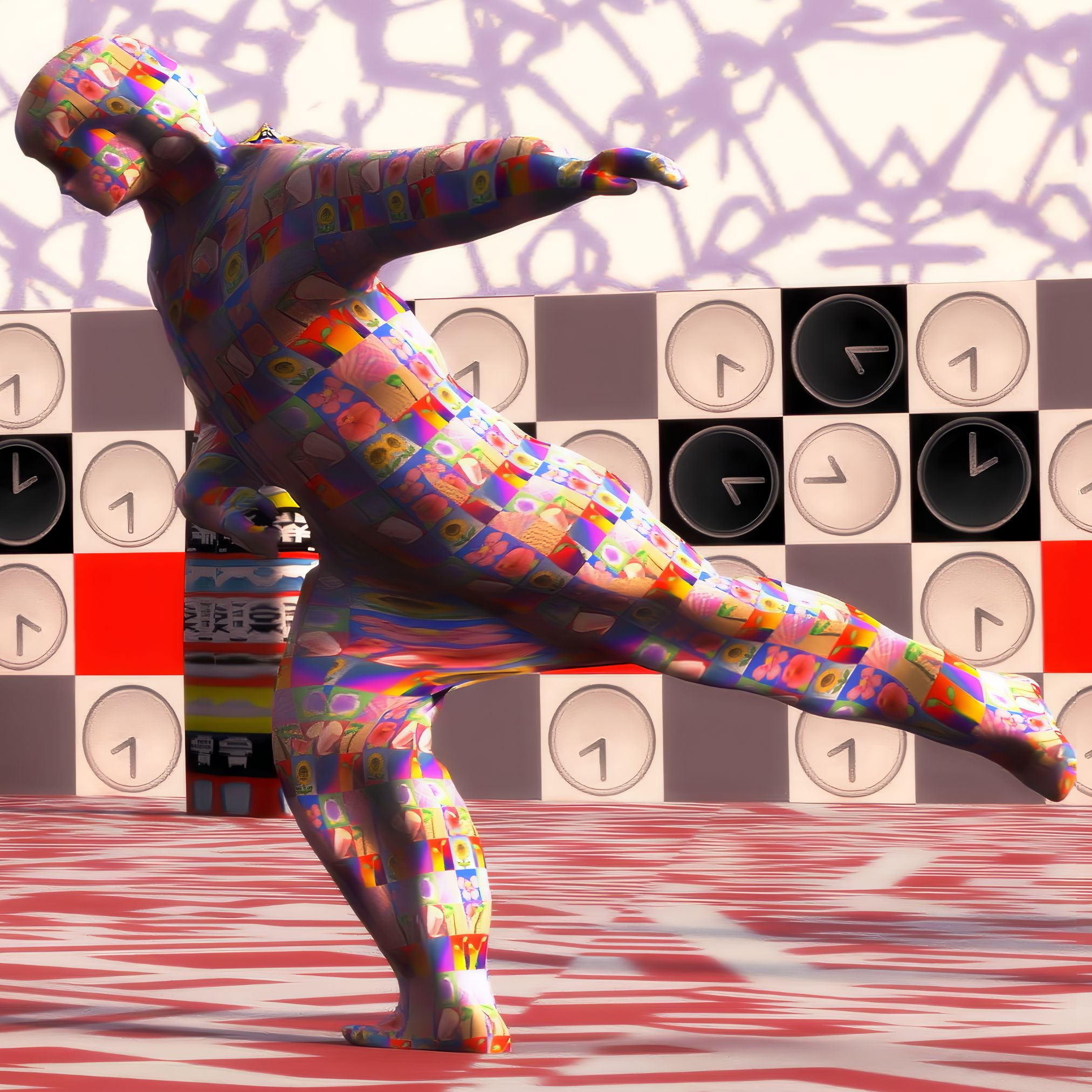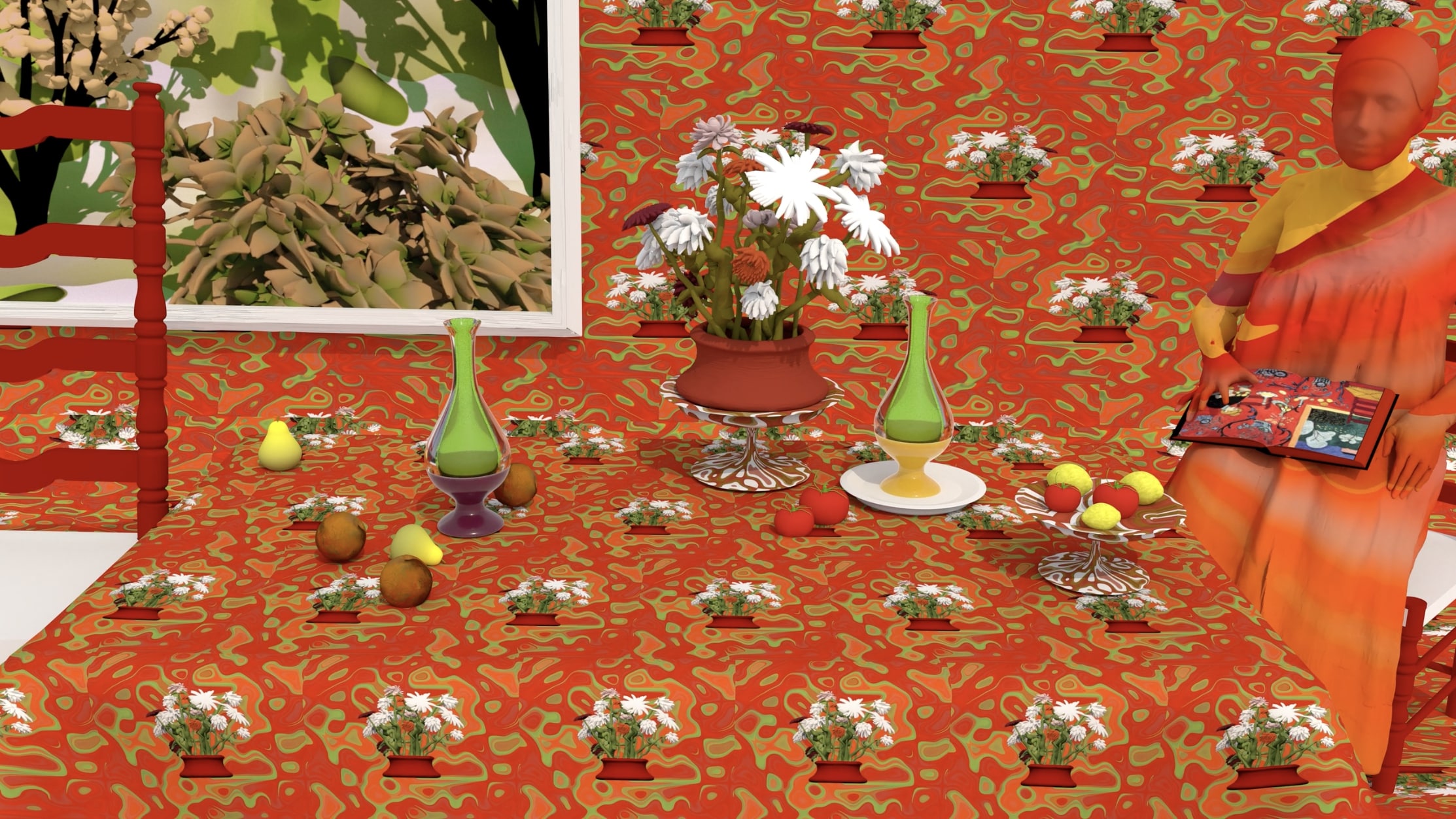
Claudia Hart on Land of the Dead

Claudia Hart on Land of the Dead
In the midst of a rich, decades-long career, media artist Claudia Hart’s work and contributions are receiving more light with three 2025 shows, including a museum retrospective and solo gallery show. The artist speaks with Peter Bauman (Monk Antony) about the uncanny “land of the dead, halfway between alive and dead” at the heart of her practice, where technology, trauma and art history converge.
Peter Bauman: For decades you’ve worked in variations of what you’ve called simulation technologies. Can you explain how that’s evolved and why simulations, or fake realities, are so central to your practice?
Claudia Hart: I'm a simulation artist. I was always interested in the history of representation. As a researcher and as an art historian from day zero, that’s what I studied at a famous art history school. I was mentored by the art historian Robert Rosenblum. He was interested in nineteenth-century art’s transitions, including the introduction of photography and shifts in representation. And that's been my frame and my fascination.
I track the history of representation and that is also very much the history of technology.
First there was Dürer with the perspective machines. Then there was Vermeer with the camera obscura. Then when I saw Toy Story, I saw this new medium. I have never in my life been interested in any way in pop culture. I'm not a mass culture person.
But when I saw that medium, I was like, “Holy shit. This is the next step after photography and perspective.”
I looked at it as a hybrid between the construction of mathematical perspective and photography; it was magical and uncanny. I've always been interested in mathematical perspectives and the distortions of camera obscura because of its potential for the magical and for its expressive quality.
It wasn't just cerebral. My interest was personal and emotional.
There’s an essay in the Patterns and Politics catalog about me in terms of the history of art as an extension of trauma. I was actually a murder victim and I somehow wasn't killed. I have had amnesia for a long period of time.
When I came to is when I started making art. The art that I was interested in was this uncanny reality. It was this land of the dead, halfway between alive and dead.
This halfway space, this uncanny, weird space, can be tracked through Dürer, Vermeer, and then Toy Story, believe it or not. Although I wasn't interested in the bugs and the toys, I was interested in this expressive, strange uncanniness of the representation.
Peter Bauman: That uncanny space perfectly suited your style, which you’ve described as “a version of magic-realism, meant to evoke fairy tales. But this is a story of disenchantment.” How is your work both a reflection of and resistance to media and technology’s impact on culture?
Claudia Hart: That's a good question. I think several things. Number one, I was trained as a historian, so I have a built-in detachment. Also, I'm a severe trauma victim and that's the way we are.

My detached worldview is crucial; I'm not in it. I'm there floating above it and watching it and framing it.
The idea that I would be pro or con is irrelevant. I'm nothing. I'm tracking it. That includes pro and con.
You also saw that with the beginnings of digital technology. The first algorithmic artists in Paris who were doing all that research weren't pro or con. Next was the later Ars Electronica phase, where the study of the emergence of new technologies became what the medium was. That was not always the case.
The built-in thing it was tracking became not the frame of representation, which to me means art; rather, it was tracking capitalist innovation culture, the tip of the arrowhead as new technologies and the development of hypermediated capitalism. That started with the invention of the internet in the '90s when the speculative market came to be.
Peter Bauman: Your work is detached but political. Your museum retrospective is even titled Patterns and Politics. What patterns were you first inspired by and how did politics also serve as gesture throughout your practice?
Claudia Hart: When I first started making work in New York in the '90s, the people of my age group were doing internet art. They were not doing what I was interested in or what I was doing. I was coming from a context of gender politics. It was performance art, inspired by queer and drag culture, as well as theater where bold decorative patterns dominated; it was anti-minimalist, called Pattern and Decoration.
It was through the lens of feminism and that was our political gesture.
The enemy was Donald Judd and Richard Serra and this hypermacho thing. The countering of that was through decorative patterns and feminizing decor. That's where I started but I kept going with it in terms of the algorithmic and the mathematical.
Peter Bauman: You can really see that Matisse-inspired, colorful maximalist work in your bitforms show from this year. How did math enter the picture?
Claudia Hart: When I was in high school and all that, I was a mathematically talented person. That was what I was supposed to study, but I dropped out of school. I was very naughty. But when I fell in love with Pixar, I taught myself all that again. So I'm self-taught, but mathematics is what I'm good at.
Then in the '90s our age group were all rediscovering Bridget Riley. Perception, mathematics and optics, are also this through line, combined with Pattern and Decoration: this mathematical nature. I wanted to use traditional floral and organic patterns; these are fractals. It was noise and fractals as pattern. Then algorithmically swapping that out for the decorative elements in painters. I like Matisse because of all that pattern and decoration. Then I'm swapping it out for noise.

Peter Bauman: As someone who's been involved in technology and art for decades, what shifts have recently stood out and how have you responded?
Claudia Hart: Well, obviously, NFTs. It's art combined with a credit card. It sits on money, which makes it gigantically different.
Although I'm using as advanced technologies as anyone, I'm looking at it through the guise of history, which is a big no-no in the land of big media arts festivals. I'm not going “ra, ra, ra.” I'm looking at it as a historian scientist with this detachment.
I'm not endorsing any of it but I want to try it all the time.
When NFTs came out, I thought, “Oh, that's an extension of hyperreality because you're actually writing or inscribing it into realness.” That, to me, was really exciting. When I wrote about the Feminist Manifesta of the Blockchain at Hyperallergic, I was totally excited. I saw it as an extension of Pattern and Decoration and the politics of my youth, where you could invent your gender just by writing it.
You self-declare and inscribe that into the blockchain, which is like the tablet in the clouds, and it becomes real. But then I changed my mind later because it got to emphasizing techno-utopianism and hypercapitalism as a goal.
Peter Bauman: That also seems to align with your thinking about breaking the systems you work with. How does that allow for improvisation and resistance to binary thinking?
Claudia Hart: The thing that happened when I started teaching at the School of the Art Institute, which is part of this big museum called the Art Institute of Chicago, is that I was teaching art students. I developed one of the first programs using VR and simulation technologies but it was meant for artists. I had taught in engineering schools but this was for artists.
The school was critical. I worked with them on inventing language, inventing ways of talking about this stuff and positioning it in history.
But the most important thing for them and me is technology’s ability to express. To express, you have to be able to break the rules, be free-reeling, intuitive.
Who cares if you've set up these rules conceptually? In the end, it doesn't matter. What matters is how expressive it is. Is it moving, emotionally expressive? To be that, you have to be fluid and intuitive and break your own rules and not be driven by the software’s rules.
That was part of being an artist. I'm a geek. I'm an experimentalist. I love doing stuff I don't know how to do, and I like to do it myself. That also includes, “Oh, AI and NFTs. Oh, cool. A new thing I can figure out.” That's what makes me happy. That's where the enthusiasm comes in.
As for the less savory side, the art market and the hyper-commercialization in this are repugnant also.
But art has always been the terrain of kings, queens and Louis XIV. The Medicis, they were not nice. Art has always gone with power and money.
Peter Bauman: That enthusiasm was evident when you curated a group show at Microscope Gallery in New York, The First Circle: Radical Humanism, which brought together artists from your generation working with technologies. Can you talk about what you were trying to accomplish with the show?
Claudia Hart: This is perfect because it's completely in keeping with everything we’ve been talking about. I wanted to look back at technology and the history of artists working with technology who were not pushing innovation capitalism. I started with my generation, people born in the postwar era, beginning with the early adoption of computers in the 1970s.
My rule set was you could not have been trained as an engineer. No engineers allowed.
You have to be dealing with representation. I did not want abstract algorithms. I wanted to deal with the history of representation. This is post-photography, image-based work.
Once I got rid of engineers, it was astonishing because everybody in there came from painting, sculpture, theater or installation-based practice. That's the core of everybody in this thing. There was a lot of playfulness.
I'm proposing an alternative history: not that it was a crossover between engineering and artists. I'm rejecting that. I'm saying that the first tech artists were intuitive, playful rule breakers.
-----
Claudia Hart is a trans-media artist, considered a pioneer in virtual imaging. Since 1990, the artist has taken a feminist position in the world of simulation technologies, inverting the rationalist voice and aesthetic language of Western canons. Hart rather transforms them into something absurd, fantastical, haunting and often dark. Her show Patterns and Politics (Francisco Carolinum Linz, curated by Julia Staudach) is the first museum retrospective of the artist’s work. She also had a 2025 solo show at bitforms, Claudia Hart: Illuminations, and curated the group exhibition, The First Circle: Radical Humanism (Microscope Gallery, New York).
Peter Bauman (Monk Antony) is Le Random's editor in chief.




